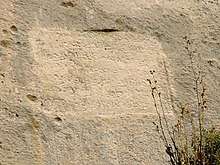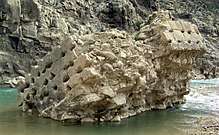Mihr Narseh
| Mihr Narseh | |
|---|---|
 Inscription of Mihr Narseh in Gor | |
| Born |
4th century Abruwan, Ardashir-Khwarrah, Pars |
| Died |
5th century Abruwan, Ardashir-Khwarrah, Pars |
| Allegiance |
|
| Rank | Wuzurg framadār |
| Battles/wars |
Roman–Sasanian War (421–422) Battle of Avarayr |
Mihr Narseh (Middle Persian: 𐭬𐭲𐭥𐭭𐭥𐭮𐭧𐭩 mtrnrshy), was a powerful Iranian nobleman from the House of Suren, who served as minister (wuzurg framadār) of the Sasanian Empire during the reigns of the Sasanian kings Yazdegerd I (r. 399-420), Bahram V (420–438), Yazdegerd II (r. 438–457) and Peroz I (r. 457–484).
Biography
Mihr-Narseh was born in the 4th-century in the village of Abruwan in the rural district of Dasht-e Barin in the administrative division of Ardashir-Khwarrah, in southwestern Pars. He was the son of a certain Boraza, who may have owned Dasht-e Barin as part of his fief. According to the medieval historian al-Tabari, Mihr Narseh traced his descent back to the mythical king Vishtaspa and the first Parthian king, Arsaces I.[1]
In 453, Yazdegerd II moved his court to Nishapur in Khorasan to face the threat from the Hephthalites and left Mihr Narseh in charge of the Sasanian Empire. Mihr Narseh later retired in Pars.[1] He may have been succeeded by Suren Pahlav. He had three sons named Zurwandad, Kardar, and Mahgushnasp.
Constructions

In the early 5th-century, Mihr Narseh had a bridge built in Gor. A inscription was also written on the bridge, which says; "This bridge was built by order of Mihr-Narseh, wuzurg framadār, for his soul's sake and at his own expense... Whoever has come on this road let him give a blessing to Mihr-Narseh and his sons for that he thus bridged this crossing."[2] Furthermore, he also founded four villages with a fire-temple in each of them. The name of the fire-temples were; Faraz-mara-awar-khwadaya, Zurwandadan, Kardadan, and Mahgushnaspan. He had a fifth fire-temple constructed in Abruwan, which may have been the Barin fire-temple that the 10th-century Persian geographer Istakhri visited, who stated that the fire-temple had an inscription that stated 30,000 dirhams was spent for its construction.[1]
References
- 1 2 3 Daryaee 2012.
- ↑ Perikhanian 1983, pp. 661-662.
Sources
- Daryaee, Touraj (2012). "MEHR-NARSEH". Encyclopaedia Iranica.
- Perikhanian, A. (1983). "Iranian Society and Law". The Cambridge History of Iran: The Seleucid, Parthian, and Sasanian periods (2). Cambridge: Cambridge University Press. pp. 627–681. ISBN 978-0-521-24693-4.
- Pourshariati, Parvaneh (2008). Decline and Fall of the Sasanian Empire: The Sasanian-Parthian Confederacy and the Arab Conquest of Iran. London and New York: I.B. Tauris. ISBN 978-1-84511-645-3.
- Gazerani, Saghi (2015). The Sistani Cycle of Epics and Iran’s National History: On the Margins of Historiography. BRILL. pp. 1–250. ISBN 9789004282964.